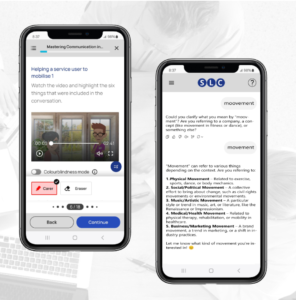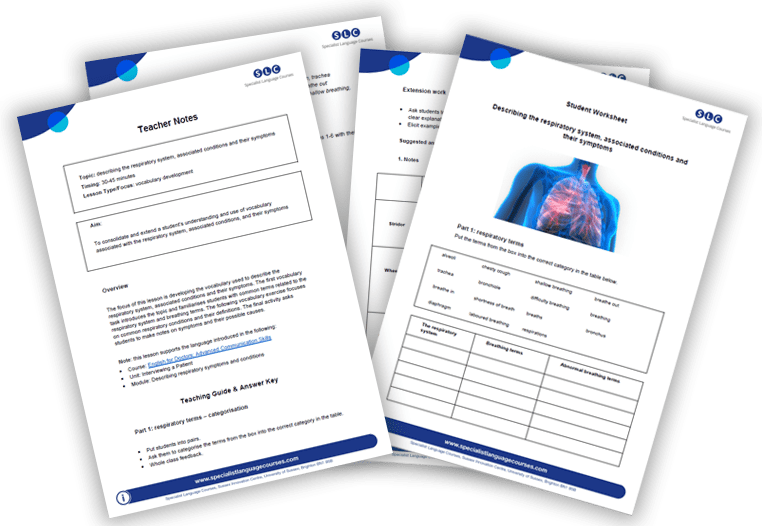
SLC win Ufi grant to develop AI language learning app for social carers
We’re delighted to have won a grant from Ufi VocTech Trust to develop an AI-driven technology solution that provides cheap phone-based language and communication skills

My latest reading is a chapter in ‘The Handbook of English for Specific Purposes’, titled ‘English for Nursing’ and written by Susan Bosher. The Handbook is a great resource for all things ESP. In the article, Bosher cites three studies, one Canadian (Epp and Lewis 2008), one American (Cameron 1998), and one Australian (Hussin 2002). Each of them looks at nurses’ English language needs, and describes in some detail what areas of language use are most common. This in turn helps inform us what language tasks and skills should be integrated into the online English for Nursing courses we design.
For this post, I’d like to discuss the Canadian study. Epp and Lewis (2008) spent over 80 hours observing nurses in various clinical settings, taking notes on their communicative interactions, and them analysing them in terms of percentages spent on different tasks. They found that nurses spent 56% of their time with patients, 34% with other healthcare professionals, and 10% with patients’ families. In terms of actual language tasks, the breakdown was as follows:
This breakdown of language use into functions is interesting and enlightening. It shows a number of key language tasks that should be integrated into any Medical English course. ‘Asking for information’ includes the grammar of questions (“Could you tell me..?”, “What happens if..?”, “How does it feel when..?”), as well as the vocabulary relevant to the context. This might range from asking about specific symptoms, to asking about pain, assessing pressure areas, carrying out a falls risk assessment, or asking about breathing difficulties.
Explaining is clearly crucial to effective communication, and again can be approached from a grammatical angle – describing sequences, cause and effect, or conditionals using ‘if-clauses’ (“If this happens, then this might happen”), as well as a vocabulary perspective. There are many interactions that require a degree of explaining, such as taking medications and their potential side-effects, common hospital procedures, pre-operative preparation, post-operative care, or giving an accurate handover.
In fact, each of the above functions listed has its own common grammar and vocabulary. What really matters here is that nurses learn the English necessary to communicate accurately with patients, other healthcare professionals (nurses, doctors, consultants), and patients, in order to ensure the provision of safe, effective care. This consists of 3 core areas:
Coming back to the Epp and Lewis’ list, while it describes the various functions nurses use English for in practice, it doesn’t go into the specific contexts in which they were using the language or identify how high stakes the interactions were. These may also be of considerable significance and impact on how a Medical English course writer designs a syllabus. For example, ‘asking for help’ only accounted for 2% of interactions. However, this specific function, especially in emergencies, may be incredibly important to get right and it therefore may assume equal importance to another language task where the stakes – and the consequences – are not so high or serious.
To take this survey further, one move may be to research a ‘Nursing English’ corpus of how English is used by nurses in practice. Corpus linguistics is a relatively new approach to language analysis but one which is having greater and greater impact on how English courses are being designed and taught. Corpus linguistics is the study of ‘real life’ samples of English, so taking large bodies of language – both written and spoken – and looking in detail at how language is used by people in practice in many different situations, in ‘real life’. To do this for nurses would be a difficult but very useful exercise. Getting a deep understanding of how English is used by nurses would allow us to develop syllabi matching the specific grammatical, lexical and communicative needs of nurses.
Until this happens, though, it is vital to use the input provided by the research of Epp and Lewis as well as others in the same field. I would also suggest we combine it with the insights provided by practising nurses. Virginia Allum, who writes our online English for Nurses courses, is a Registered Nurse, with career experience in the UK and Australia, and has also lectured extensively on English for Medical Purposes. This enables her to write courses which demonstrate a strong understanding of the issues facing non-native English-speaking nurses, as well as a real command of the environment nurses work in.
Designing online English of Nursing courses has proven to be a fascinating task so far. We are developing two courses, one at an elementary/pre-intermediate level for nurses preparing or just starting to work in an English-speaking environment, and one at a higher intermediate/upper-intermediate level, for practising non-native nurses who need to improve their accuracy, fluency and confidence in the workplace.
References: ‘English for Nursing’ by Susan Bosher, p263-281, ‘The Handbook of English for Specific Purposes’, edited by Brian Partridge and Sue Starfield, published by Wiley Blackwell, 2014
The material in these articles and powerpoint come from SLC’s course, English for Nursing. This English for Nurses course teaches you the English you need to study and work in an English-speaking healthcare environment, attend conferences and seminars, and keep up with nursing journals and research written in English.
SLC’s ground-breaking online Medical English courses gives you the language you need to work, study and collaborate in an English-speaking environment.
Just click on the course and start your Medical English preparation!
In Specialist Language Courses we offer free lesson plans to teachers so they can have the best materials to teach their students about Medical English.
You can subscribe to our newsletter where you will receive monthly email with the latest materials that SLC offers for free.

We also offer the latest in online medical English resources and materials to transform your teaching programmes and accelerate your students’ learning.
Teachers and institutions use the courses in multiple ways – as digital coursebooks, as supplementary learning, and as part of a flipped classroom approach. We can advise you how to integrate the materials to meet your objectives.
Interested in using our courses? Click here:
Get your monthly updates and latest materials on Medical English

We’re delighted to have won a grant from Ufi VocTech Trust to develop an AI-driven technology solution that provides cheap phone-based language and communication skills

Back to Menu ↩ What is the UK Foundation Programme? The UK Foundation Programme is a two-year, structured, work-based training programme which is designed to
